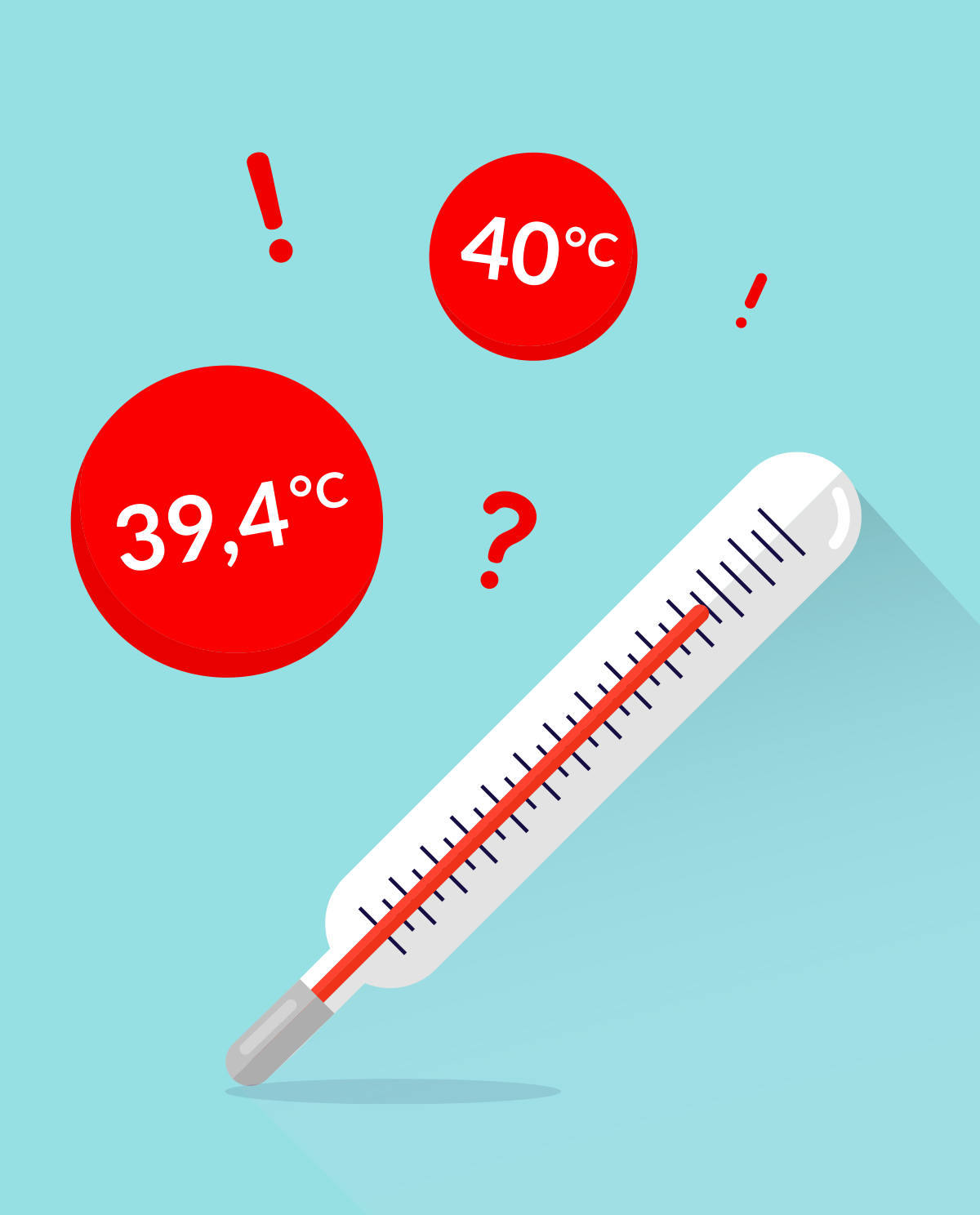What is fever?
Fever is our natural defensive reaction against factors that trigger inflammation. It usually appears as a result of intrusions into the body, such as viruses, bacteria, fungi, foreign bodies or allergens - these are so-called external pyrogens. After coming into contact with them, the cells of the immune system start producing their own fever-provoking substances. The internal pyrogens are then created, affecting the thermoregulatory center located in the hypothalamus. They change the biological set point of body temperature to a higher level. Then, our body attempts to adapt intensely to maintain a new, higher temperature, for example when our muscles tremble (often referred to as ‘chills’).
How many degrees is indicative of a fever?
It is generally accepted that the correct temperature of the human body is 36.6 ° C. However, this is not entirely true. The result that we get depends primarily on the place of measurement and the accuracy of the thermometer used. In addition, the temperature of our body undergoes natural daily fluctuations - increasing in the afternoon (16:00 - 18:00) and reducing around 6:00 in the morning. There is also a dependence on activity - crying, anger and physical exertion can be the reason for its increase. Higher temperature is also observed in people using a high protein diet and during ovulation in menstruating women. In healthy people, the normal temperature ranges are:
- children:
- anus: 36.6–38.0 °C
- tympanic membrane: 35.6–37.7 °C
- axillary: 35.6–37.2 °C
- forehead: 35.6–37.9 °C
- adults:
- anus: 34.4–37.8 °C
- tympanic membrane: 35.4–37.8 °C
- axillary: 35.5–37.0 °C
- mouth: 33.2–38.2 °C
A temperature exceeding 38.0 - 38.5 °C is reason to be concerned - we are then talking about a fever. However, a temperature ranging from 37.0 to 38.0 °C is a low-grade condition.
How can your temperature be measured?
What thermometer should we choose and where can we measure the temperature? This question has no unequivocal answer, because each of the measurement methods has its pros and cons. The most important thing is to use the same thermometer and the place of measurement throughout the duration of the disease. That way we can exclude any issues as a result of taking temperature readings from varying body parts which may be slightly warmer or colder. The place where the temperature is measured depends on the child's age.
| Age | Recommended method |
|---|---|
| from birth to 2 years | recommended measurement in the rectum; measurement in the region of the temporal artery or under the armpit (screening) |
| 3-5 years | recommended measurement in the ear or mouth; measurement under the armpit or around the temporal artery (screening); measurement in the rectum, if necessary, verification |
| >5 years | recommended measurement in the mouth or ear; measurement under the armpit or around the temporal artery (screening); measurement in the rectum, if necessary, verification; |
*axillary - is considered the least accurate point of measurement
When should you "kill" a fever?
An increase in body temperature is a natural defense mechanism of the body. Therefore, temperatures below 38.0 °C (some sources say 38.5 - 39.0 °C) should not be lowered. Remember that a good tolerance of fever is crucial here. If we feel relatively fine, we can refrain from administering antipyretics. The same applies when the fever is affecting your child, if their behaviour is relatively normal, if they have a good appetite and drink a lot, they are probably tolerating the fever quite well. However, if the fever causes suffering such as a headache, then you can take an antipyretic. With children, it’s very important observe their behaviour. If your child is in pain, feeling overworked, is refusing to eat, drink or starts to show additional symptoms indicating an infection (e.g. vomiting) then they should be given an antipyretic.
Antipyretic drugs and their dosage
Paracetamol – it is a painkiller and antipyretic, but has no anti-inflammatory effect.
- It can be used from the first days of a child's life.
- Children should be given 10-15 mg/kg body weight every 4-6 hours.
- Children should be given 10-15 mg/kg body weight every 4-6 hours.
- Adults can take 1-2 tablets. (500-1000 mg) every 4-6 hours. Do not exceed the dose of 4g/day (8 tablets) or, if we use the drug for more than 2-3 days, the dose of 2.5g (5 tablets).
- Attention! Paracetamol is part of many complex drugs, so check their composition to avoid overdosing.
Ibuprofen – it is a painkiller, antipyretic and anti-inflammatory.
- It can be used after the third month of a child's life.
- Unless there are contraindications, it should be the first choice of drug due to its anti-inflammatory effect.
- Children should be given 5-10 mg/kg body weight every 6-8 hours.
- Adults can take 1 tablet, or 200 mg ("forte" tablets containing 400 mg of the drug are also available) every 6-8 hours. The maximum daily dose is 1.2 g (6 tablets of 200 mg or 3 tablets of 400 mg).
- Attention! Do not administer this medicine in chickenpox (increases the risk of bacterial infections) and in peptic ulcer disease (increases the risk of bleeding).
There is a very good calculator of antipyretic syrups on the mamaginekolog.pl website (authored by Alicja Jaczewska and Jakub Wójcicki).
Other antipyretics:
Naproxen
- It is not recommended for children under 16 years of age with indications other than juvenile rheumatoid arthritis (JRA).
- Adults can take 1 tablet, i.e. 250-500 mg, then another tablet, if necessary, every 6-8 hours. The maximum daily dose is 1250 mg (5 tablets of 250 mg each).
- Attention! Do not drink alcohol during treatment. Use with caution in elderly patients.
Aspirin = acetylsalicylic acid
- Attention! Aspirin should not be used in children <12 years of age due to the risk of Reye's syndrome.
- Adults may use 1-2 tablets, ie 300-600 mg every 4 h (also "max" substances containing 500 mg of the drug are available). The maximum daily dose is 3 g (10 tablets of 300 mg).
Metamizole (pyralgina)
- Attention! In children, <15 years of age can be used only in severe, life-threatening fever, when other antipyretics are ineffective or contraindicated.
- Adults can use 1-2 tablets (500-1000 mg). The maximum daily dose is 6 tablets (3000 mg metamizol). Do not use this medicine for more than 3 to 5 days without consulting your doctor. It’s not recommended for use in elderly or people with liver or kidney problems.
How do you use antipyretics?
- Do not use preparations containing combined substances, e.g. paracetamol and ibuprofen in one syrup or tablet. This is important as it can cause vomiting.
- If a person with fever vomits after taking an antipyretic drug (e.g., ibuprofen), do not re-administer the same drug because we are not able to estimate how much medicine remained in the stomach and was absorbed. It is then recommended to include a second antipyretic (e.g. paracetamol).
- If a person with fever is vomiting or has problems swallowing, consider giving them an antipyretic in the form of suppositories.
- The time intervals indicated above concern the next doses of the same drug and should be strictly observed. It is worth noting down the temperature measurement and the time, the name and dose of the administered drug.
- If the fever continues, it is worth taking one kind of medicine regularly to maintain its continuity (e.g., paracetamol every 4 hours or ibuprofen every 8 hours).
- If one drug is not enough and the fever increases before the next dose of the same drug - in the interval between successive doses of the parent drug (e.g. ibuprofen) you can give the second drug (e.g. paracetamol). It is important to remember to keep the right intervals between each dose of the same drug.
Ways you can fight fever at home
- drinking a lot of fluids - we lose a lot of water during fever, so drinking adequate amounts of liquids, preferably still mineral water (appropriate to the age and weight of the person). With infant fever, breastfeeding should be used to satisfy the thirst if possible. It is also worth checking the humidity and temperature of the room.
- cold compresses - you can put a cold compress on the forehead and neck, it should bring some relief if you’re too hot. Applying a cold compress to the groin and under the right rib arch works too, because there is a large flow of blood and the body cools down faster.
- cool bath- the temperature of the water should be only 1-2 degrees lower than the body temperature.
- raspberry juice and infusions of herbs, such as: lime, blackberry, raspberry (the leaves have diaphoretic properties). It is recommended to take drinks like this at bedtime, and in the case of heavy sweating, it is necessary to change the pyjamas.
Keep in mind that home remedies do not replace antipyretic drugs and its administration may be necessary with poor fever tolerance.
When should you talk to a doctor?
- there is no decrease in temperature despite the administration of 2 types of antipyretics (e.g. paracetamol and ibuprofen) of the appropriate dose,
- the child is under 12 months old,
- fever persists for at least 3 days, responds to medication, but returns,
- vomiting or diarrhea has occurred, especially in a small child,
- breathing has changed, dyspnoea, cyanosis,
- there is a barking cough or wheezing,
- a rash has occurred,
- the amount of urine decreased significantly, or there is haematuria, pain or burning when passing it,
- the fever is accompanied by a severe headache,
- convulsions appeared (not to be confused with feverish chills),
- if there is a significant, disturbing change in the behaviour of the child, e.g. significant stimulation,
- if the child does not want to drink, they’re listless or they’re oversleeping.
- Interna Szczeklika 2018 Internal Diseases Handbook, Authors: Piotr Gajewski, Andrzej Szczeklik Publisher: Medycyna Praktyczna
- E.Kuchar, Body temperature measurement and its interpretation, "Practical Pediatrics Medicine. Common problems in pediatric practice in questions and answers ", special edition 2/2017, p. 15
- http://www.mp.pl
- https://www.mp.pl/pacjent/
- https://www.mp.pl/pytania/pediatria/najnowsze-pytania/178525,jakim-termometrem-mierzyc-temperature-u-dziecka
- https://www.mp.pl/pacjent/pediatria/lista/83121,zasada-pomiaru-temperatury-u-dzieci
- https://www.mp.pl/pacjent/zapytajlekarza/lista/show.html?id=61427
- https://mamaginekolog.pl/goraczka/
- https://www.lekarzdladzieci.pl/pediatria/goraczka/








